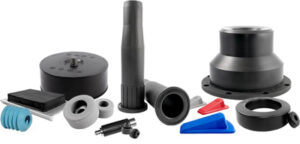Quality versus quantity: How changes in EPDM polymer impact molding
Carlee Manges, Kristi Ferrato – Alltran Technical Services
Shorter cycle times, decreased scrap rates, and excellent physical properties must all be balanced by practical rubber compounding and appropriate processing conditions to benefit both the manufacturer and end user. The industry continues to shift towards tighter part tolerances, greener processes and lower cost. These demands require precise test equipment and rubber knowledge to understand how these process and formulation variables affect key performance indicators and aid in continuous plant wide improvements.
EPDM is a widely used polymer for many molded goods, as it is inherently water, ozone, UV and weather resistant, and generally recommended for temperatures ranging from -50°C to 150°C. EPDM can be a low cost material option, as it allows for high total loading and has a low specific gravity, yielding low pound-volume cost. EPDM responds well at various process temperatures, and is used in many applications, such as seals, gaskets, weather resistant parts, NSF 61 water potable applications, FDA applications, roofing components, electrical resistant compounds, and more.
There are three main types of molding processes: compression molding, transfer molding and injection molding. Each type of molding process has pros and cons, and requires different key material properties for best results in molding cycles, cavity fill, scrap rates, knit lines and resulting material properties. Development work can be done in the laboratory, via RPA simulations, spider molds, and monitoring viscosities and scorch times.

